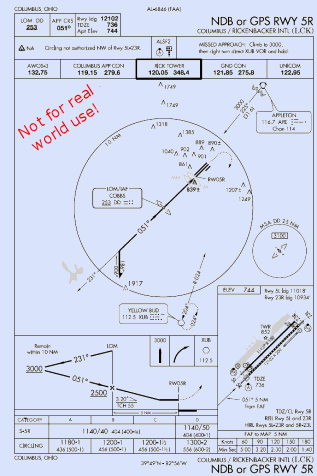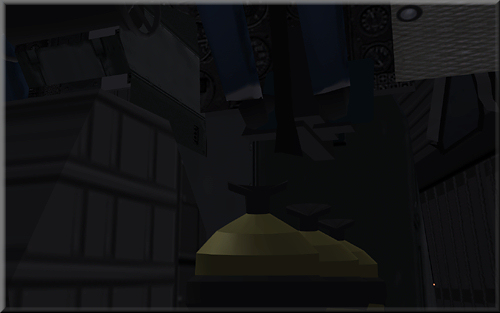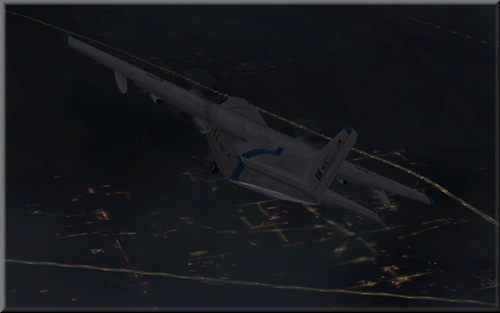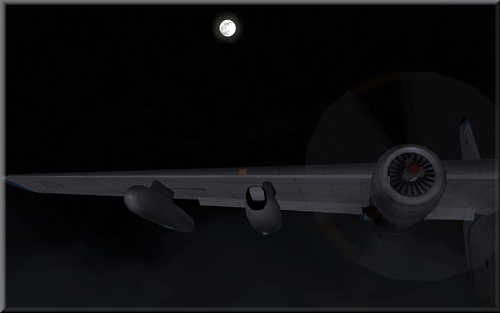|
Chapter 4
"Coping"
How
things change, I reflect as I scan the instruments by
flashlight. Fifteen minutes ago – less, just about five
minutes ago – we were motoring along merrily over
Tennessee with strobes and beacons flashing and the
autopilot dutifully flying our 50,000 lbs of airplane
exactly as we wished it to, talking on the radio to
Memphis Center and finding our way by radio beams.
Well, I thought wryly, we’re still motoring along over
Tennessee, and our gross is still about 50,000 lbs, but
most of the rest of that happy picture has evaporated in
a puff of smoke – or two puffs of smoke. The first took
our radios and autopilot away. The second took most
everything else. Still, there are some bright spots. The
engines are fat, dumb and happy out there on the wings,
just as they were before. Most of our basic flight
instruments are functional and we have a couple of
flashlights to read them by. And Joe just happened to
have a brand new, shiny, hand-held GPS.
He returns to the flight deck after a few long minutes,
and slides into his seat, carefully re-fastening the
belt. He produces two objects; the GPS that may well be
our salvation and - - -? A roll of duct tape? Aha, I
think, realizing what he has in mind.
 |
Just the thing for
covering up those disorienting turn coordinators. He
proceeds to do just that. We’re never going to live this
down if they find out about it back in Ocala.
That done, he fires up the GPS and begins to rapidly
push the buttons on the face. What he’s doing is
unfamiliar to me, but he’s clearly spent some time with
it and seems to be confident. |
“Turn right to 020, Boss; we missed the turn at Hinch
Mountain VOR, but we can get back on the airway before
JELLO intersection”, he says without hesitation. I start
the turn, carefully, roll into it, adding a little back
pressure; don’t worry about the airspeed, just stay on
the altitude. I’m rusty, but not too much. I usually do
this kind of thing by twisting the heading knob on the
HSI. I turn through 30 degrees and steady up on 020,
cross-checking HSI and magnetic compass. It looks like
the HSI gyro is vacuum operated. That’s a blessing.
Flying by magnetic compass is possible, but difficult.
I’m still scanning using the flashlight and Joe is
punching keys for all he’s worth, occasionally
consulting our route sheet. He’s entering our waypoints,
I suspect. While he’s busy with that, I’m busy thinking.
This is going to take some thinking through and tonight
will be no time to be behind the airplane. We need to
anticipate everything we can.
Joe gives me another heading instruction a couple of
minutes later and returns to his keyboard. I make the
turn, this time a little to the left. I can see the
back-lighted, four-color display on his new toy, but
it’s too small and far away to read it, much less to
comprehend what he’s doing.
By the time he’s finished, I’ve come to some decisions.
“Joe, I’ve begun to think this through. Let me lay this
out as I see it. If you have suggestions or you think
I’ve overlooked or mis-calculated anything, let me
know.” He nods, watching me intently.
|
I keep my eye on the instruments as I speak. “I think we
continue to Rickenbacker and should stay at 12,000 all
the way there. I’ve just looked at the approach plates.
5R is the long runway, 12,100 feet plus a 1,000 ft.
overrun pad. There’s a GPS approach for 5R and the IAF
is the outer marker. We’ll fly the last enroute leg
direct to the fix. Once we hit that we can fly a hold
over it and descend in the hold until we’re ready to
shoot the approach. By the time we’ve made one circuit,
ATC will have figured out what we’re up to and will be
getting everyone out of our way. They won’t know we
don’t have lights, but they probably already know we
can’t talk or hear. They must have seen our transponder
go away. I think they’ll be able to follow our primary
radar target better if we stay high. We’ll use the time
between here and there to configure us for landing; I
think it would be best to do that in straight and level
flight anyway.”
“The only navaids on the approach plate are the outer,
middle and inner markers. We won’t have them, but the
GPS should tell us what we need. We won’t have a current
altimeter setting either, but the ceiling is forecast at
800 AGL and the MDA for the approach is almost 400 feet
below that. We should be in the clear well before the
MDA and we can add a couple of hundred feet to
compensate for any altimeter setting error. That will
keep us on the safe side if conditions don’t look like
the forecast.”
|
 |
I didn’t know what we’d try next if that didn’t work,
but didn’t say so.
“What was your last fuel hack?” He bent down on his side
and fished out the clipboard, reading it with his
flashlight.
“At KIRCH intersection we had three thousand twenty five
pounds – that was…19 minutes ago.” He sure has gotten
blabby, I think to myself.
“OK, now for the hard part. We need the landing gear and
if possible, the flaps. They’ll have to be pumped down
by hand, and it’s going to take a while, so I want to
start pretty soon. We ought to throttle back some before
we start and get about 20 knots off her, but we need to
remember that the props are as they are. They won’t
adjust without electrical power, so I’m not too sure how
she’ll behave. Ideally I’d like to get the flaps out
first, but I’m not sure we have enough time, so I’m
going to start with the gear and we’ll get whatever we
can manage on the flaps in the time that’s left. With me
so far?” I see his nod out of the corner of my vision.
“Next point is, you understand that little box in your
hand and you know how to operate it – I don’t – and this
isn’t the time for me to learn. Can you fly the plane
and navigate with that thing at the same time while I’m
pumping down the gear and flaps? Remember that you’ll
have to deal with a slow, continuous configuration
change. Do you think you can do that? If you’re not
comfortable with what I’m proposing, say so, and we’ll
think of something else.”
He hesitated for a few seconds, then said, “It’s OK. I
can do it.” I’d never doubted he could, but both of us
needed to hear him say it.
“OK, are you all set up on the GPS?” He nods. “Let’s
slow her down to 145 then. I think you ought to take the
controls, but I’ll stay here until you’re slowed down.
Let’s go a little richer on the mixtures as you reduce
the power. We don’t have any way of gauging that now and
we should err on the rich side.”
A few minutes later we were steady at 145 knots, still
holding 12,000 feet. I hadn’t touched the controls. Joe
had managed the throttles and the trim and the
flashlight and his GPS as if he did this sort of thing
every night. I was ready to jump in if he needed me, but
he didn’t. The props hadn’t been a factor, though we
didn’t have any idea of RPM or manifold pressure any
more. The control scheme must have required electricity
somewhere along the line. I wondered about manifold
pressure and if we were straining the engines by flying
level this slow with the props at a coarse pitch. Can’t
be helped. We get what we get.
“OK, Tiger. I’m going to go back and look over the pump
station, get the valves lined up, then I’ll bring my
flashlight back to you. I want you to have a spare. I
won’t need one to operate the pump. I’ll be back in a
flash.” Another nod, but he doesn’t break his scan.
Twenty more minutes have passed, and I’m back at the
manually operated hydraulic pump station for the second
time. This time I’m in the dark. The pump station is set
in a cavity in the forward cargo hold bulkhead, port
side, just at the deck level. I’d removed the cover
plate and read the instructions on the battered plate on
my first trip here and had already aligned the valves to
pump the landing gear out into the slipstream. All that
had taken quite some time. The pump has two operating
modes, fast and slow. For relatively fast operation, two
pistons, one large and one small, are operated in
parallel by the pump handle to displace oil from the
reservoir into the system. Once operating effort in that
mode becomes too great, and it will, the operator can
slide a little link bar and essentially take the larger
of the two pistons out of the picture. At that point it
will be slow going, but the effort required to operate
the handle will be reduced in proportion. I wonder how
long I’ll last in high speed mode.
Thankfully, the area around the pump cavity is clear of
cargo. The Provider cargo bay is about 31 feet long from
the forward bulkhead to the break of the ramp hinge.
Because of CG parameters, cargo is more or less
concentrated near the center, under the wing, spreading
fore and aft equally. Tonight none of it obstructs the
area around the pump cavity. I make a mental note to
have the almost obliterated yellow “KEEP CLEAR” zone on
the floor repainted soon.
The only reasonably comfortable position for operating
the pump handle is to sit on the floor. My knees
complain a little as I sit myself down and get a two-
handed grip on the handle, which moves laterally,
parallel with the deck, about a foot and a half above
it. It seems that the best position is to sit facing
inboard with my legs parallel to the bulkhead and my
back against the folded ladder of the port side cabin
door. It’s not comfortable, but it lets me move the
handle more or less in the fashion of a rowing machine
and get my back into it. I begin slowly, moving the
handle back and forth in the dark. I’m surprised to find
that it pumps on both strokes. Not sure if I like that
or not; it’s awkward in one direction no matter how I
position myself. Well, it can’t be helped. This isn’t so
bad, I think. I can do this.

About a thousand strokes later, eight hundred of them
after shifting the pump to slow speed mode, I’m
wondering whether I can do this or not. The pump effort
had increased quickly once the gear started moving. I
could hear the change in the slipstream noise as they
began to creep out ever so slowly, pushing the gear
doors open ahead of them. At first I could. Now all I
can hear is my lungs heaving and my heart pumping and my
blood rushing through my tired veins. This is hard work!
I have no idea how far out they are and am wondering how
I’ll know when to stop. I suspect that the pump handle
will become pretty much immoveable once all three gear
legs are up against the stops. I hope so. We don’t have
any little green lights on the panel to tell us.
After a few hundred strokes more, each a little slower
than the last as my strength flags, I feel a steep
increase in the effort required. Within a stroke or two
the handle is solid. Thank God, I think as I sag
sideways against the forward bulkhead for a minute to
catch my breath. I close the stop cock to the landing
gear circuit by feel, preventing the air pressure on the
gear from pushing oil back out of the extended
cylinders.
After that short respite I haul myself, complaining
knees and all, back to an upright position and move
toward the steep steps up to the flight deck. In the
first half-step, I bang my leg painfully against the now
rock solid pump handle protruding from the bulkhead
cavity. Recovering after some salty expletives I limp
the few steps toward the flight deck access way,
supporting myself with a hand on the bulkhead as I go. I
heave myself up, still panting like a dog.
I sit down and belt in, just in case. Joe gives me a
quick look, then returns to his scan. “Gear is down.” I
say as my breathing slows somewhat and I slip my headset
back on. “I’ll need the light when I go back to make the
valve lineup for the flaps.”
“Not much time”, he says.
“How close are we?”
He consults the GPS in his lap. “Thirty-nine miles to
the marker.”
I do the math. A little over 15 minutes. Damn! I was
longer with the gear than I thought. “OK, Joe, I’m going
back right away. I’ll need the flashlight to get the
pump lined up and won’t waste the time to bring it back.
When we’re at 4 miles, shine your light through the
access way and wave it around. I’ll see it and come
back. Be prepared to enter the hold without me, but
don’t descend until I’m back and belted.” Without
waiting for an answer, I pulled the headset off,
unbuckled the belt and squirmed out of the seat,
avoiding the yoke. Once more into the breech…
The flaps proved easier, in terms of effort. I was able
to keep the pump in high speed mode, but couldn’t judge
how much progress I’d made. I can remember a whole
series of actuator cylinders spaced across the length of
each flap, five per side, at least. More cylinders meant
less effort, but more oil. I give up trying to estimate
how far I’d progressed and just keep sawing away with
the pump handle. Soon I see the beam of Joe’s light
waving back and forth through the access way. We’re out
of time. I quickly close the flaps stop cock and this
time, stow the pump handle before making my way back to
the flight deck.
“How does she feel”, I ask after getting settled back
in.
“Nose is down a little, and I’ve had to add power;
they’re down some.” I looked out my side window, craning
my neck to see how much I’d pumped them down but can’t
see a thing. It’s too dark and the angle is all wrong. I
just can’t tell.

Joe banks us into the first turn of the racetrack above
the approach fix. “It’s 231 degrees outbound, left
turns”, he volunteers, trying to look at his watch while
juggling the GPS and flashlight and maintaining his bank
angle. I hadn’t thought of that. The panel clocks were
both dead.
“I’ll call the times for you.” I looked at my watch,
noting the second hand at 5. We needed one minute
intervals, four to a circuit, entering or exiting a turn
alternately at each.
“Let’s talk through our plan before we descend. It’s
going to be busy from here to touchdown.”
“OK”
I consulted the approach plate again. We’ll make the
last outbound leg at 3,000. As soon as we roll out on to
that leg we’re in the approach procedure. I’ll take over
at 7,000 so you’ve got a few minutes to study the
approach plate. Is that enough?”
“Yes”
“OK, I’d like you watching the GPS and giving me updates
once we’re out of the hold. You’ll be our localizer.
Call the procedure turn 5 miles out from the outer
marker. Give me the time hacks for the procedure turn.
Cue me on intercepting the approach course. Once we roll
out of the procedure turn start calling out the distance
to the threshold at one mile intervals. The marker is
exactly 5 miles from the threshold. Final approach
course is 050. We’ll stay level at 3,000 through the
procedure turn, which is to the left. We start down and
cross the fix inbound at 2,500. We’ll use the altimeter
setting we have now and fly all the altitudes as the
procedure shows, but we’ll add 200 ft. to the MDA. That
will make the MDA 1340. - - - Mark, one minute.” He
moves the yoke and the wings roll level.
“If we don’t go missed approach, the field elevation is
744, but we’ll have to remember our altimeters won’t be
very accurate. We’re going to have to eyeball that at
touchdown and we don’t have any landing lights either.
Those runways at Rickenbacker are lit up like the Las
Vegas strip though.”
“I expect they’ll have everyone out of our way, but if
there’s traffic, see and avoid is our responsibility.
Without lights, no one is going to see us until too
late, if they see us at all. If someone’s on 5R, a
side-step to 5L is an option but we’ll have to watch for
traffic. 5L has a displaced threshold and if we move
over, we’ll need to add power and go longer; it looks
like about 2,000 ft. longer on the airport diagram.
They’re close together though. We should get a green
light from the tower while we’re on final, if they can
find one, but if we get a look at either runway and
there’s no interfering traffic, we’ll land, green light
or not.”
“Mark…” another turn begins.
“If we reach 1340 and don’t see anything, we’ll have to
go missed approach, but I surely hope that’s not
necessary. We’re heavy, we can’t retract the gear or
flaps and the propellers are fixed at cruise pitch. I
don’t know how she’ll perform, but it won’t be what
we’re used to. The jets aren’t an option. The starters
and the igniters both need power. I think we’ll be able
to climb but we won’t set any records. The missed
approach procedure is straight ahead on the runway
heading, climb to 3,000, turn right and pick up the 024
radial to Yellow Bud VOR. Hold there. Can you see Yellow
Bud on there?”
He glances down, presses a button. “Yes.”
“We can only guess where the flaps are, so I’m going to
fly the approach at 130 knots. That’s a little over two
miles a minute to get from 2,500 at the outer marker to
744 in five miles. Two and a half minutes for, say 1,750
feet. Sounds like I’ll need about 700 fpm, assuming no
wind. At each mile after the marker, note my altitude
and tell me if I’m high or low. I need 2,150 at 4 miles,
1,800 at 3, 1,450 at 2 and 1,100 at a mile. If I’m on
it, we’ll reach MDA at about a mile and a half. If the
forecast is accurate and our altimeter setting isn’t too
far off, we should break out around two miles. That’s
the closest to a glide slope I can come up with. They
have approach slope lights, so we’ll have some guidance
from them once we break out.”
“I’m going to try to touch down as close to the numbers
as I can. There’s a lot of runway, but I want as much of
it in front of us as I can manage. We’re fast and heavy
and probably don’t have a lot of flaps out. I can’t use
the wheel brakes until 90 knots, but be ready to help me
on them when I do begin braking if I call for it. If I
toast them, they won’t be any help at all. We should
have plenty of stopping distance. What do you think?”
“I’m ready.”
“Mark, one minute.” We roll level again.
“Start us down whenever you’re ready. Use whatever feels
comfortable, we won’t have ATC asking us to expedite
tonight.” He nods and smiles, just a little; he’s
starting to relax. Good! We both need to believe we can
pull this off.
“Keep it fairly shallow. I don’t think we want to get
her sinking too fast.” Another silent nod. “I’ll handle
the mixtures as we descend.”
And so, we’re just about to step onto the down
escalator. I should be scared, I think to myself. Too
busy I guess. If I were just sitting here with nothing
to do this would be a lot worse. We have 9,000 feet of
altitude to get rid of now. If he sets up at 500 fpm
that’s 18 minutes to the beginning of the procedure.
Seems like a long time. Well, genius, it was your idea
to stay high all the way here. Don’t whine about it now.

End – Chapter 4

Click on
logo to download chapter 4 as pdf |